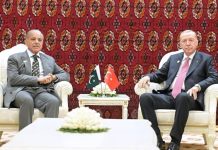By Anzal Amin
ISLAMABAD: A long-awaited loan agreement between Pakistan and the International Monetary Fund (IMF) will be signed once a few remaining points, including a proposed fuel pricing scheme, are settled, an IMF official confirmed on Friday.
The coalition government and IMF have been negotiating since early February on an agreement that would release $1.1 billion to the cash-strapped country of 220 million people.
The latest issue is a plan, announced by Prime Minister Shehbaz Sharif last week, to charge affluent consumers more for fuel, with the money raised used to subsidise prices for the poor, who have been hit hard by inflation, which in February was at its highest in 50 years.
Petroleum Minister Musadik Malik told Reuters on Thursday that his ministry had been given six weeks to work out the pricing plan.
But the IMF’s resident representative in Pakistan, Esther Perez Ruiz, said the government did not consult the fund about the fuel pricing scheme.
Ruiz, in a message to Reuters, confirmed a media report that a staff-level agreement would be signed once a few re-maining points, including the fuel scheme, were settled.
She added that the fund would ask the government for more details about the fuel proposal, including how it would be implemented and what protection would be put in place to prevent abuse.
The petroleum and finance ministries did not immediately respond to a request for comment.
With enough foreign reserves to only cover about four weeks of necessary imports, Pakistan is desperate for the IMF agreement to disperse a $1.1 billion tranche from a $6.5 billion bailout agreed upon in 2019.
The government has already implemented several fiscal measures, including devaluing the rupee, lifting subsidies and raising energy prices as preconditions for the agreement, which Finance Minister Ishaq Dar said this month was “very close”.
Meanwhile, Julie Kozack, director of communications at the IMF, said in a press briefing Thursday that “timely financial assistance from external partners will be critical to support the authorities’ policy efforts and ensure the successful completion of the review”.
When asked to elaborate on what is needed from the said external partners, Kozack said: “At this point, ensuring that there is sufficient financing to support the authorities is the paramount priority.” She added that a staff-level agreement would follow once the few remaining points were closed. “I can also say that financing assurances, right, what we’re looking for here are a standard feature of all IMF programs,” she said.
“Aside from support provided by the IMF, Pakistan’s, EFF supported program receives financing from other multilat-eral institutions, including the World Bank, the ADB, and the AIIB and bilateral partners, notably China, Saudi Arabia, and the UAE,” Kozack added.
“So, we do need to ensure that we have those financing assurances in place in order for us to be able to take the next step with Pakistan.”
She also mentioned that Pakistan’s economy faces “multiple challenges including from slowing growth, high inflation and large financing needs”. And of course, this is all coming on the back of devastating floods.
Kozack, also acknowledged that Pakistani authorities “are committed to implementing the necessary reforms” and that “they’ve started to implement decisive actions to stabilise the economy and restore confidence”.
Earlier this week, the government shared its strategy for the recently-announced fuel relief programme, which is to be implemented in three phases and will “provide a relief of up to Rs50 per litre to the poor”.
The scheme’s announcement had come days after the government increased the prices of all petroleum products — except the insignificant light diesel oil — by up to Rs13 per litre for the next fortnight.
In a report that detailed the pricing strategy behind the Prime Minister’s Petroleum Relief Programme, the govern-ment said it has developed a two-tier pricing programme that would provide relief to two-wheelers (motorcycles), three-wheelers (rickshaws) and small vehicles by dividing the consumers into the categories of “poor” and “rich”.
The programme aims to target roughly 20 million motorcycles and rickshaws (with a capping of 21 litres of fuel) & 1.36m small vehicles (with a capping of 30 litres of fuel) currently active across Pakistan, the report stated.
Using differential pricing wherein the base price of fuel is assumed to be Rs300 per litre, the “poor” will be provided relief of up to Rs50 by charging the “rich” an additional Rs102 per litre.
The resulting assumed prices would be Rs250 for the “poor” and Rs352 for the “rich”.
The report further said that the programme will use two models for its implementation — an e-discount through OTP and a “fuel card”.
The implementation will be done in three phases with the first being an increment in the base fuel price (Rs300) of Rs75 — setting the new price without relief at Rs375 — and the collection of money in an escrow account.
In the second phase, the government will “use two different registration mechanisms to enrol the beneficiaries”.
One mechanism would involve data being uploaded by the Vehicle Registration Authority to the National Database and Registration Authority (Nadra) while the other would have the consumer register their vehicle via SMS.
In the final phase, the discount will be dispersed to the beneficiary after they have registered on the relevant registra-tion portal and a transaction has been processed at the fuel station.
The Ministry of Energy (Petroleum Division) will supervise the roles and responsibilities of various actors involved in the plan — including Nadra, the Oil & Gas Regulatory Authority, oil marketing companies and the National Bank of Pa-kistan.



